Reflective practice and Organizational Development PDF
VerifiedAdded on 2021/05/30
|13
|3581
|58
AI Summary
Contribute Materials
Your contribution can guide someone’s learning journey. Share your
documents today.
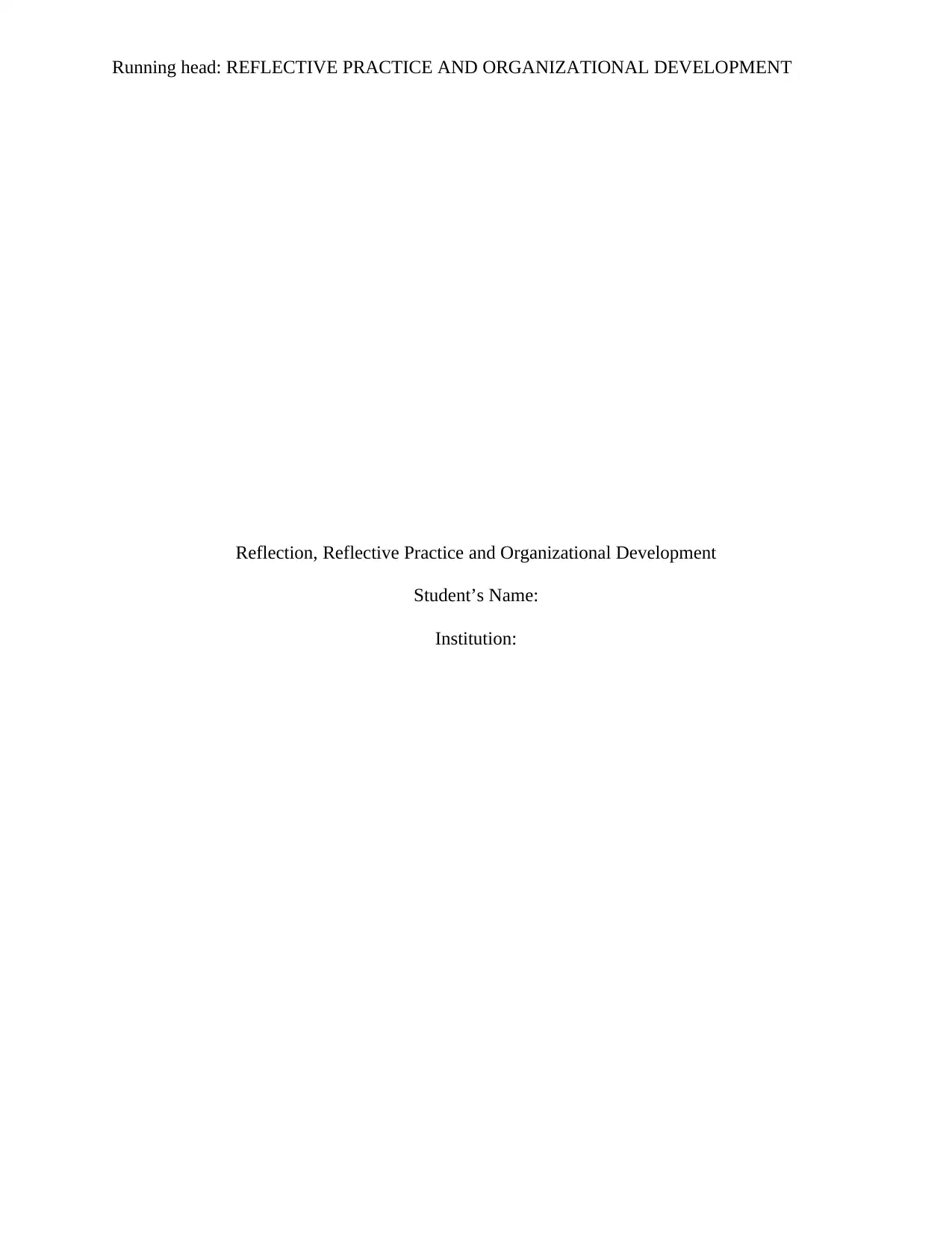
Running head: REFLECTIVE PRACTICE AND ORGANIZATIONAL DEVELOPMENT
Reflection, Reflective Practice and Organizational Development
Student’s Name:
Institution:
Reflection, Reflective Practice and Organizational Development
Student’s Name:
Institution:
Secure Best Marks with AI Grader
Need help grading? Try our AI Grader for instant feedback on your assignments.
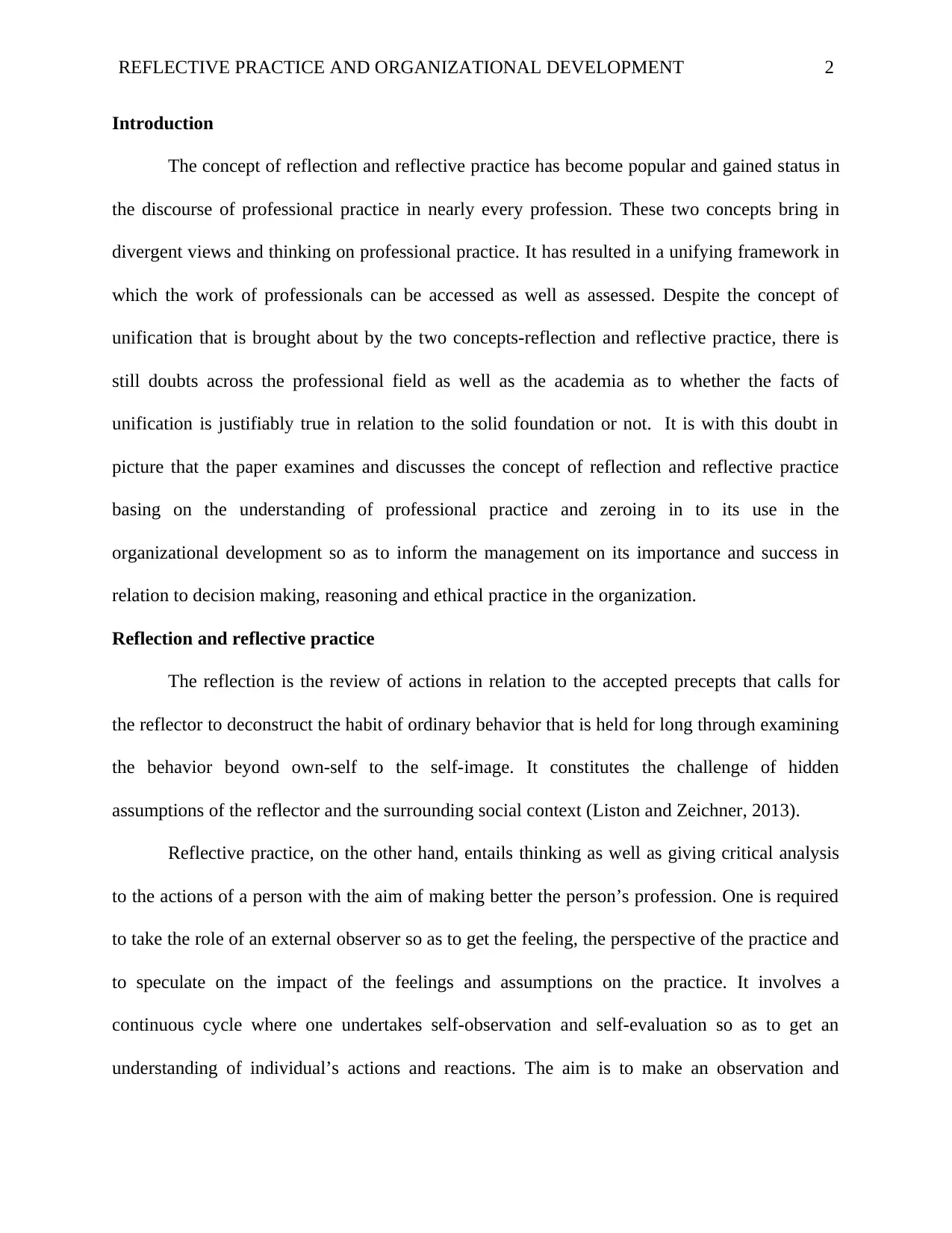
REFLECTIVE PRACTICE AND ORGANIZATIONAL DEVELOPMENT 2
Introduction
The concept of reflection and reflective practice has become popular and gained status in
the discourse of professional practice in nearly every profession. These two concepts bring in
divergent views and thinking on professional practice. It has resulted in a unifying framework in
which the work of professionals can be accessed as well as assessed. Despite the concept of
unification that is brought about by the two concepts-reflection and reflective practice, there is
still doubts across the professional field as well as the academia as to whether the facts of
unification is justifiably true in relation to the solid foundation or not. It is with this doubt in
picture that the paper examines and discusses the concept of reflection and reflective practice
basing on the understanding of professional practice and zeroing in to its use in the
organizational development so as to inform the management on its importance and success in
relation to decision making, reasoning and ethical practice in the organization.
Reflection and reflective practice
The reflection is the review of actions in relation to the accepted precepts that calls for
the reflector to deconstruct the habit of ordinary behavior that is held for long through examining
the behavior beyond own-self to the self-image. It constitutes the challenge of hidden
assumptions of the reflector and the surrounding social context (Liston and Zeichner, 2013).
Reflective practice, on the other hand, entails thinking as well as giving critical analysis
to the actions of a person with the aim of making better the person’s profession. One is required
to take the role of an external observer so as to get the feeling, the perspective of the practice and
to speculate on the impact of the feelings and assumptions on the practice. It involves a
continuous cycle where one undertakes self-observation and self-evaluation so as to get an
understanding of individual’s actions and reactions. The aim is to make an observation and
Introduction
The concept of reflection and reflective practice has become popular and gained status in
the discourse of professional practice in nearly every profession. These two concepts bring in
divergent views and thinking on professional practice. It has resulted in a unifying framework in
which the work of professionals can be accessed as well as assessed. Despite the concept of
unification that is brought about by the two concepts-reflection and reflective practice, there is
still doubts across the professional field as well as the academia as to whether the facts of
unification is justifiably true in relation to the solid foundation or not. It is with this doubt in
picture that the paper examines and discusses the concept of reflection and reflective practice
basing on the understanding of professional practice and zeroing in to its use in the
organizational development so as to inform the management on its importance and success in
relation to decision making, reasoning and ethical practice in the organization.
Reflection and reflective practice
The reflection is the review of actions in relation to the accepted precepts that calls for
the reflector to deconstruct the habit of ordinary behavior that is held for long through examining
the behavior beyond own-self to the self-image. It constitutes the challenge of hidden
assumptions of the reflector and the surrounding social context (Liston and Zeichner, 2013).
Reflective practice, on the other hand, entails thinking as well as giving critical analysis
to the actions of a person with the aim of making better the person’s profession. One is required
to take the role of an external observer so as to get the feeling, the perspective of the practice and
to speculate on the impact of the feelings and assumptions on the practice. It involves a
continuous cycle where one undertakes self-observation and self-evaluation so as to get an
understanding of individual’s actions and reactions. The aim is to make an observation and
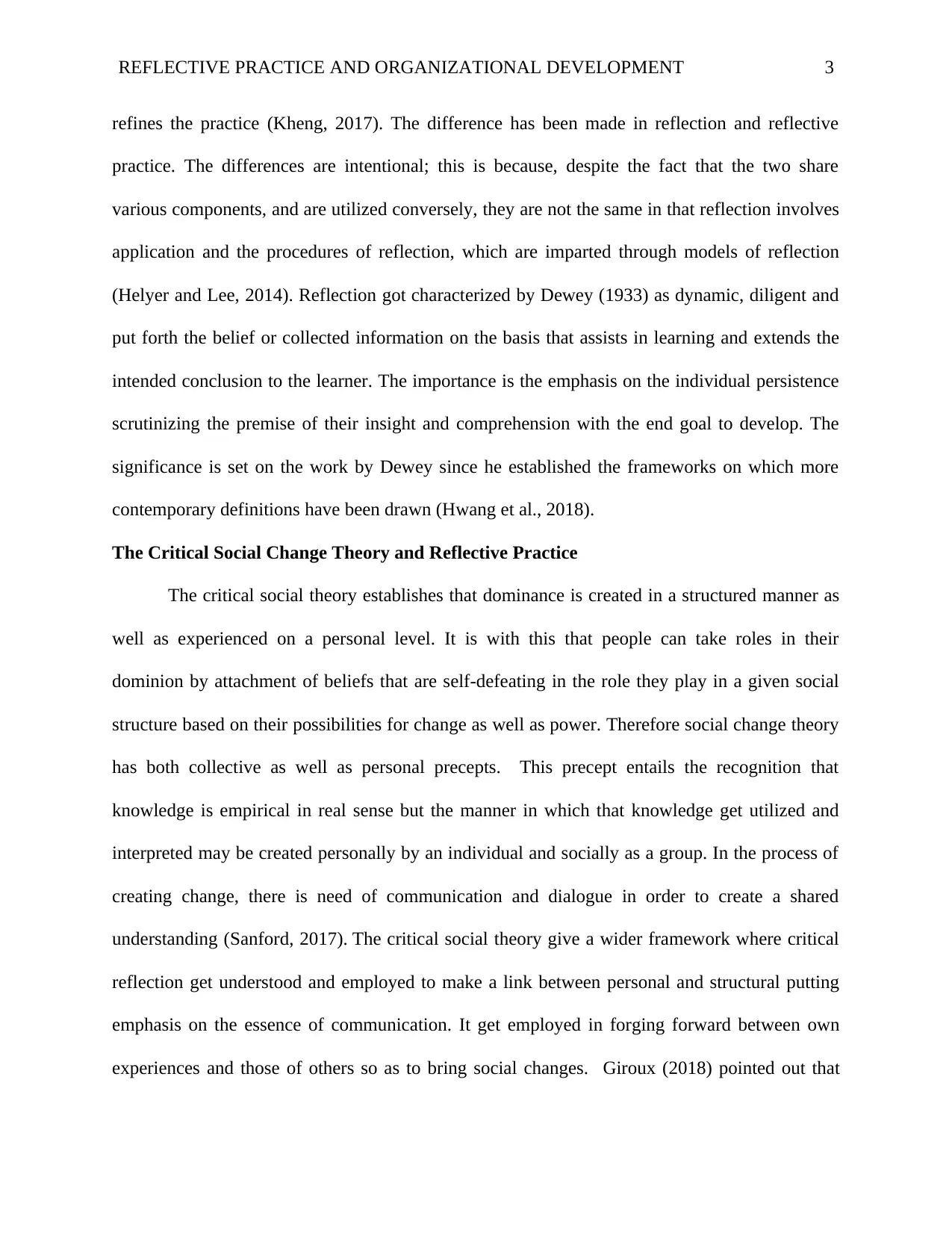
REFLECTIVE PRACTICE AND ORGANIZATIONAL DEVELOPMENT 3
refines the practice (Kheng, 2017). The difference has been made in reflection and reflective
practice. The differences are intentional; this is because, despite the fact that the two share
various components, and are utilized conversely, they are not the same in that reflection involves
application and the procedures of reflection, which are imparted through models of reflection
(Helyer and Lee, 2014). Reflection got characterized by Dewey (1933) as dynamic, diligent and
put forth the belief or collected information on the basis that assists in learning and extends the
intended conclusion to the learner. The importance is the emphasis on the individual persistence
scrutinizing the premise of their insight and comprehension with the end goal to develop. The
significance is set on the work by Dewey since he established the frameworks on which more
contemporary definitions have been drawn (Hwang et al., 2018).
The Critical Social Change Theory and Reflective Practice
The critical social theory establishes that dominance is created in a structured manner as
well as experienced on a personal level. It is with this that people can take roles in their
dominion by attachment of beliefs that are self-defeating in the role they play in a given social
structure based on their possibilities for change as well as power. Therefore social change theory
has both collective as well as personal precepts. This precept entails the recognition that
knowledge is empirical in real sense but the manner in which that knowledge get utilized and
interpreted may be created personally by an individual and socially as a group. In the process of
creating change, there is need of communication and dialogue in order to create a shared
understanding (Sanford, 2017). The critical social theory give a wider framework where critical
reflection get understood and employed to make a link between personal and structural putting
emphasis on the essence of communication. It get employed in forging forward between own
experiences and those of others so as to bring social changes. Giroux (2018) pointed out that
refines the practice (Kheng, 2017). The difference has been made in reflection and reflective
practice. The differences are intentional; this is because, despite the fact that the two share
various components, and are utilized conversely, they are not the same in that reflection involves
application and the procedures of reflection, which are imparted through models of reflection
(Helyer and Lee, 2014). Reflection got characterized by Dewey (1933) as dynamic, diligent and
put forth the belief or collected information on the basis that assists in learning and extends the
intended conclusion to the learner. The importance is the emphasis on the individual persistence
scrutinizing the premise of their insight and comprehension with the end goal to develop. The
significance is set on the work by Dewey since he established the frameworks on which more
contemporary definitions have been drawn (Hwang et al., 2018).
The Critical Social Change Theory and Reflective Practice
The critical social theory establishes that dominance is created in a structured manner as
well as experienced on a personal level. It is with this that people can take roles in their
dominion by attachment of beliefs that are self-defeating in the role they play in a given social
structure based on their possibilities for change as well as power. Therefore social change theory
has both collective as well as personal precepts. This precept entails the recognition that
knowledge is empirical in real sense but the manner in which that knowledge get utilized and
interpreted may be created personally by an individual and socially as a group. In the process of
creating change, there is need of communication and dialogue in order to create a shared
understanding (Sanford, 2017). The critical social theory give a wider framework where critical
reflection get understood and employed to make a link between personal and structural putting
emphasis on the essence of communication. It get employed in forging forward between own
experiences and those of others so as to bring social changes. Giroux (2018) pointed out that
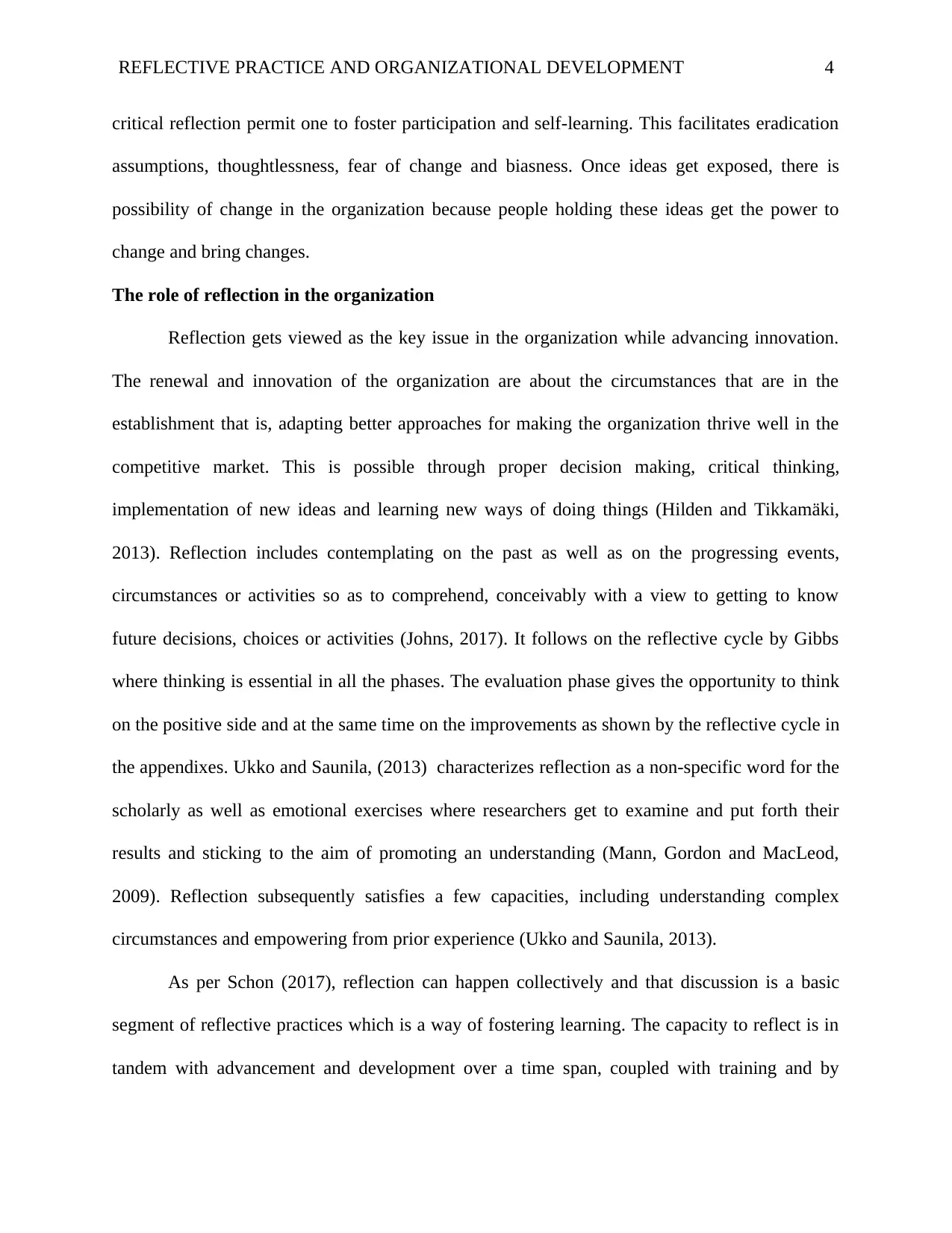
REFLECTIVE PRACTICE AND ORGANIZATIONAL DEVELOPMENT 4
critical reflection permit one to foster participation and self-learning. This facilitates eradication
assumptions, thoughtlessness, fear of change and biasness. Once ideas get exposed, there is
possibility of change in the organization because people holding these ideas get the power to
change and bring changes.
The role of reflection in the organization
Reflection gets viewed as the key issue in the organization while advancing innovation.
The renewal and innovation of the organization are about the circumstances that are in the
establishment that is, adapting better approaches for making the organization thrive well in the
competitive market. This is possible through proper decision making, critical thinking,
implementation of new ideas and learning new ways of doing things (Hilden and Tikkamäki,
2013). Reflection includes contemplating on the past as well as on the progressing events,
circumstances or activities so as to comprehend, conceivably with a view to getting to know
future decisions, choices or activities (Johns, 2017). It follows on the reflective cycle by Gibbs
where thinking is essential in all the phases. The evaluation phase gives the opportunity to think
on the positive side and at the same time on the improvements as shown by the reflective cycle in
the appendixes. Ukko and Saunila, (2013) characterizes reflection as a non-specific word for the
scholarly as well as emotional exercises where researchers get to examine and put forth their
results and sticking to the aim of promoting an understanding (Mann, Gordon and MacLeod,
2009). Reflection subsequently satisfies a few capacities, including understanding complex
circumstances and empowering from prior experience (Ukko and Saunila, 2013).
As per Schon (2017), reflection can happen collectively and that discussion is a basic
segment of reflective practices which is a way of fostering learning. The capacity to reflect is in
tandem with advancement and development over a time span, coupled with training and by
critical reflection permit one to foster participation and self-learning. This facilitates eradication
assumptions, thoughtlessness, fear of change and biasness. Once ideas get exposed, there is
possibility of change in the organization because people holding these ideas get the power to
change and bring changes.
The role of reflection in the organization
Reflection gets viewed as the key issue in the organization while advancing innovation.
The renewal and innovation of the organization are about the circumstances that are in the
establishment that is, adapting better approaches for making the organization thrive well in the
competitive market. This is possible through proper decision making, critical thinking,
implementation of new ideas and learning new ways of doing things (Hilden and Tikkamäki,
2013). Reflection includes contemplating on the past as well as on the progressing events,
circumstances or activities so as to comprehend, conceivably with a view to getting to know
future decisions, choices or activities (Johns, 2017). It follows on the reflective cycle by Gibbs
where thinking is essential in all the phases. The evaluation phase gives the opportunity to think
on the positive side and at the same time on the improvements as shown by the reflective cycle in
the appendixes. Ukko and Saunila, (2013) characterizes reflection as a non-specific word for the
scholarly as well as emotional exercises where researchers get to examine and put forth their
results and sticking to the aim of promoting an understanding (Mann, Gordon and MacLeod,
2009). Reflection subsequently satisfies a few capacities, including understanding complex
circumstances and empowering from prior experience (Ukko and Saunila, 2013).
As per Schon (2017), reflection can happen collectively and that discussion is a basic
segment of reflective practices which is a way of fostering learning. The capacity to reflect is in
tandem with advancement and development over a time span, coupled with training and by
Secure Best Marks with AI Grader
Need help grading? Try our AI Grader for instant feedback on your assignments.
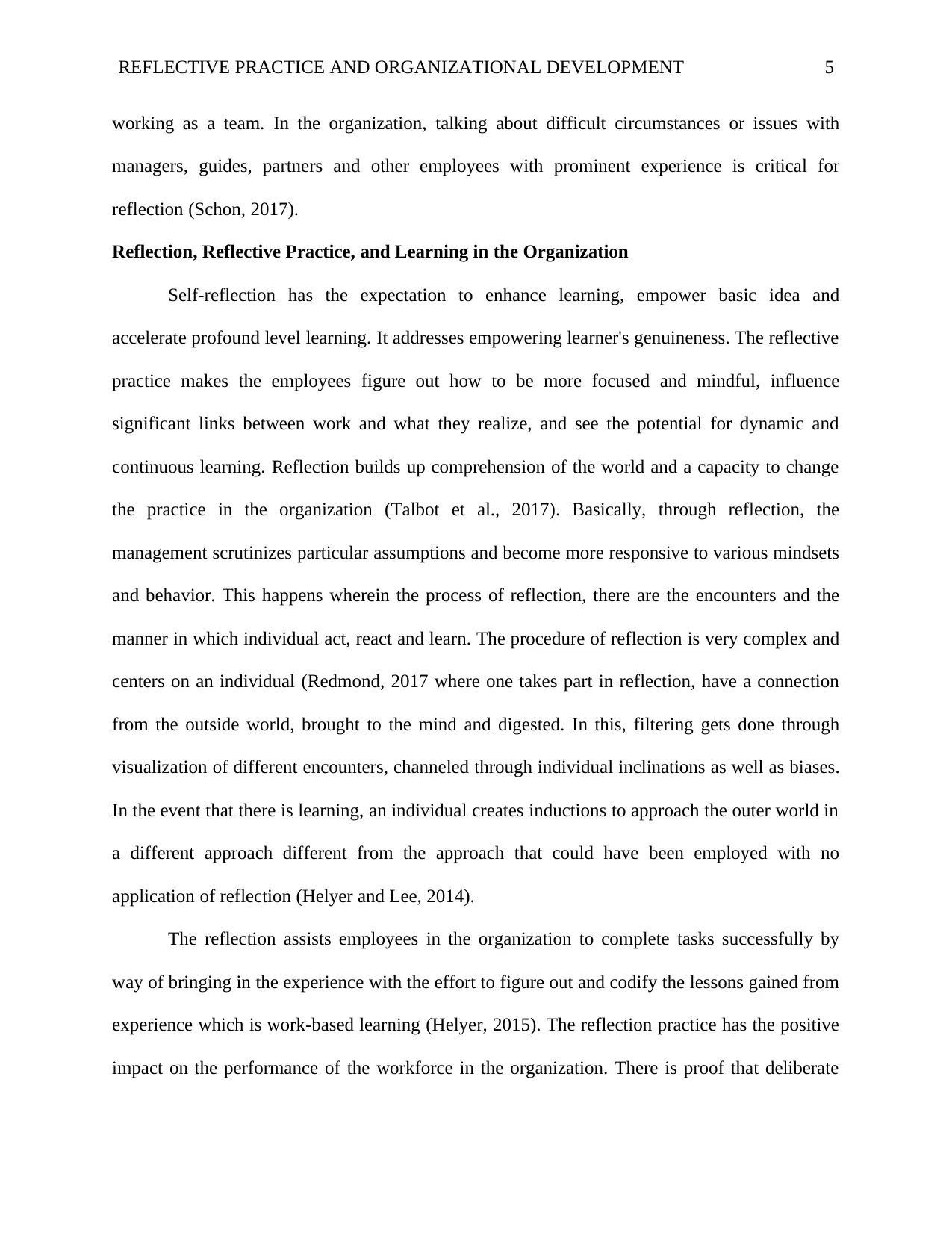
REFLECTIVE PRACTICE AND ORGANIZATIONAL DEVELOPMENT 5
working as a team. In the organization, talking about difficult circumstances or issues with
managers, guides, partners and other employees with prominent experience is critical for
reflection (Schon, 2017).
Reflection, Reflective Practice, and Learning in the Organization
Self-reflection has the expectation to enhance learning, empower basic idea and
accelerate profound level learning. It addresses empowering learner's genuineness. The reflective
practice makes the employees figure out how to be more focused and mindful, influence
significant links between work and what they realize, and see the potential for dynamic and
continuous learning. Reflection builds up comprehension of the world and a capacity to change
the practice in the organization (Talbot et al., 2017). Basically, through reflection, the
management scrutinizes particular assumptions and become more responsive to various mindsets
and behavior. This happens wherein the process of reflection, there are the encounters and the
manner in which individual act, react and learn. The procedure of reflection is very complex and
centers on an individual (Redmond, 2017 where one takes part in reflection, have a connection
from the outside world, brought to the mind and digested. In this, filtering gets done through
visualization of different encounters, channeled through individual inclinations as well as biases.
In the event that there is learning, an individual creates inductions to approach the outer world in
a different approach different from the approach that could have been employed with no
application of reflection (Helyer and Lee, 2014).
The reflection assists employees in the organization to complete tasks successfully by
way of bringing in the experience with the effort to figure out and codify the lessons gained from
experience which is work-based learning (Helyer, 2015). The reflection practice has the positive
impact on the performance of the workforce in the organization. There is proof that deliberate
working as a team. In the organization, talking about difficult circumstances or issues with
managers, guides, partners and other employees with prominent experience is critical for
reflection (Schon, 2017).
Reflection, Reflective Practice, and Learning in the Organization
Self-reflection has the expectation to enhance learning, empower basic idea and
accelerate profound level learning. It addresses empowering learner's genuineness. The reflective
practice makes the employees figure out how to be more focused and mindful, influence
significant links between work and what they realize, and see the potential for dynamic and
continuous learning. Reflection builds up comprehension of the world and a capacity to change
the practice in the organization (Talbot et al., 2017). Basically, through reflection, the
management scrutinizes particular assumptions and become more responsive to various mindsets
and behavior. This happens wherein the process of reflection, there are the encounters and the
manner in which individual act, react and learn. The procedure of reflection is very complex and
centers on an individual (Redmond, 2017 where one takes part in reflection, have a connection
from the outside world, brought to the mind and digested. In this, filtering gets done through
visualization of different encounters, channeled through individual inclinations as well as biases.
In the event that there is learning, an individual creates inductions to approach the outer world in
a different approach different from the approach that could have been employed with no
application of reflection (Helyer and Lee, 2014).
The reflection assists employees in the organization to complete tasks successfully by
way of bringing in the experience with the effort to figure out and codify the lessons gained from
experience which is work-based learning (Helyer, 2015). The reflection practice has the positive
impact on the performance of the workforce in the organization. There is proof that deliberate
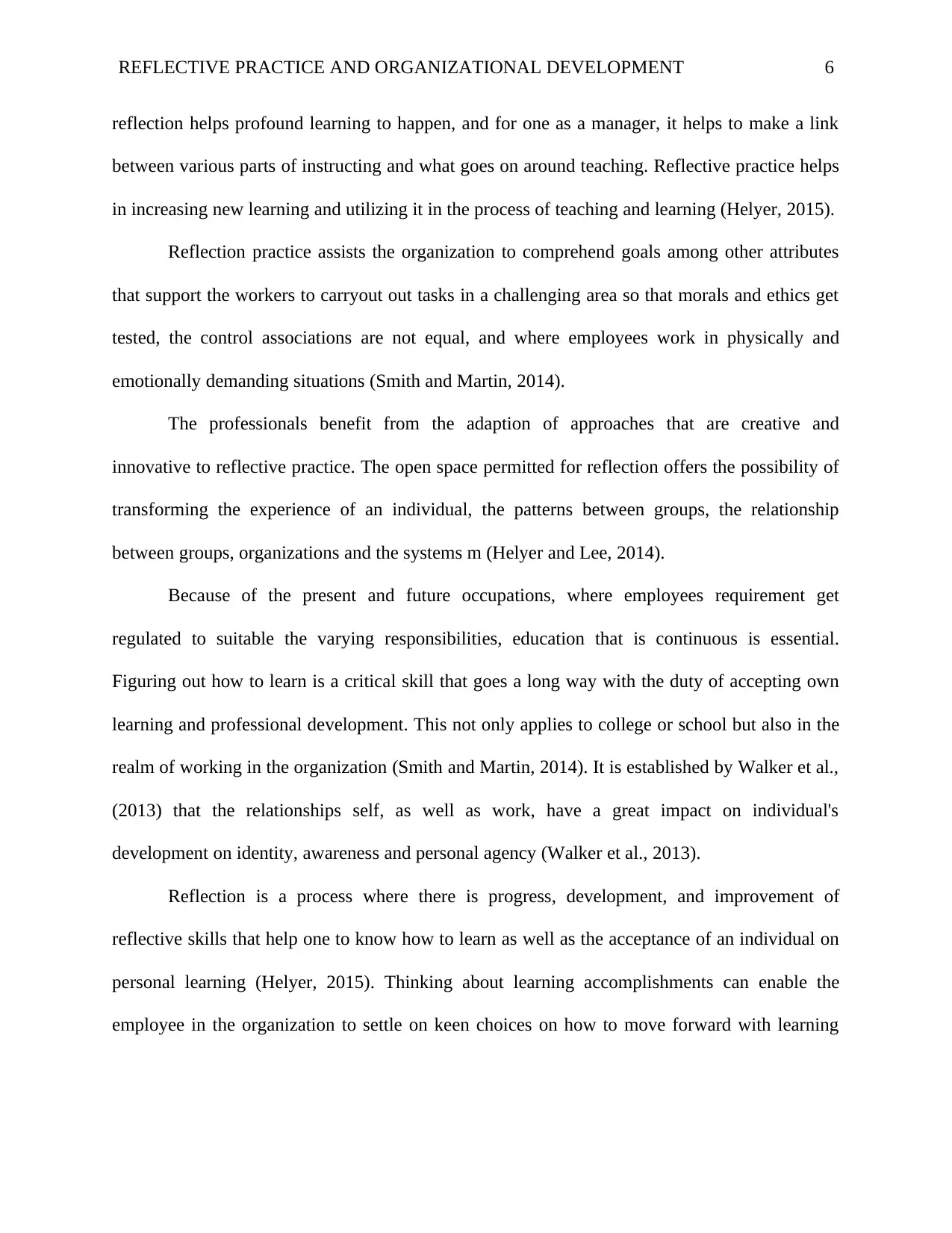
REFLECTIVE PRACTICE AND ORGANIZATIONAL DEVELOPMENT 6
reflection helps profound learning to happen, and for one as a manager, it helps to make a link
between various parts of instructing and what goes on around teaching. Reflective practice helps
in increasing new learning and utilizing it in the process of teaching and learning (Helyer, 2015).
Reflection practice assists the organization to comprehend goals among other attributes
that support the workers to carryout out tasks in a challenging area so that morals and ethics get
tested, the control associations are not equal, and where employees work in physically and
emotionally demanding situations (Smith and Martin, 2014).
The professionals benefit from the adaption of approaches that are creative and
innovative to reflective practice. The open space permitted for reflection offers the possibility of
transforming the experience of an individual, the patterns between groups, the relationship
between groups, organizations and the systems m (Helyer and Lee, 2014).
Because of the present and future occupations, where employees requirement get
regulated to suitable the varying responsibilities, education that is continuous is essential.
Figuring out how to learn is a critical skill that goes a long way with the duty of accepting own
learning and professional development. This not only applies to college or school but also in the
realm of working in the organization (Smith and Martin, 2014). It is established by Walker et al.,
(2013) that the relationships self, as well as work, have a great impact on individual's
development on identity, awareness and personal agency (Walker et al., 2013).
Reflection is a process where there is progress, development, and improvement of
reflective skills that help one to know how to learn as well as the acceptance of an individual on
personal learning (Helyer, 2015). Thinking about learning accomplishments can enable the
employee in the organization to settle on keen choices on how to move forward with learning
reflection helps profound learning to happen, and for one as a manager, it helps to make a link
between various parts of instructing and what goes on around teaching. Reflective practice helps
in increasing new learning and utilizing it in the process of teaching and learning (Helyer, 2015).
Reflection practice assists the organization to comprehend goals among other attributes
that support the workers to carryout out tasks in a challenging area so that morals and ethics get
tested, the control associations are not equal, and where employees work in physically and
emotionally demanding situations (Smith and Martin, 2014).
The professionals benefit from the adaption of approaches that are creative and
innovative to reflective practice. The open space permitted for reflection offers the possibility of
transforming the experience of an individual, the patterns between groups, the relationship
between groups, organizations and the systems m (Helyer and Lee, 2014).
Because of the present and future occupations, where employees requirement get
regulated to suitable the varying responsibilities, education that is continuous is essential.
Figuring out how to learn is a critical skill that goes a long way with the duty of accepting own
learning and professional development. This not only applies to college or school but also in the
realm of working in the organization (Smith and Martin, 2014). It is established by Walker et al.,
(2013) that the relationships self, as well as work, have a great impact on individual's
development on identity, awareness and personal agency (Walker et al., 2013).
Reflection is a process where there is progress, development, and improvement of
reflective skills that help one to know how to learn as well as the acceptance of an individual on
personal learning (Helyer, 2015). Thinking about learning accomplishments can enable the
employee in the organization to settle on keen choices on how to move forward with learning
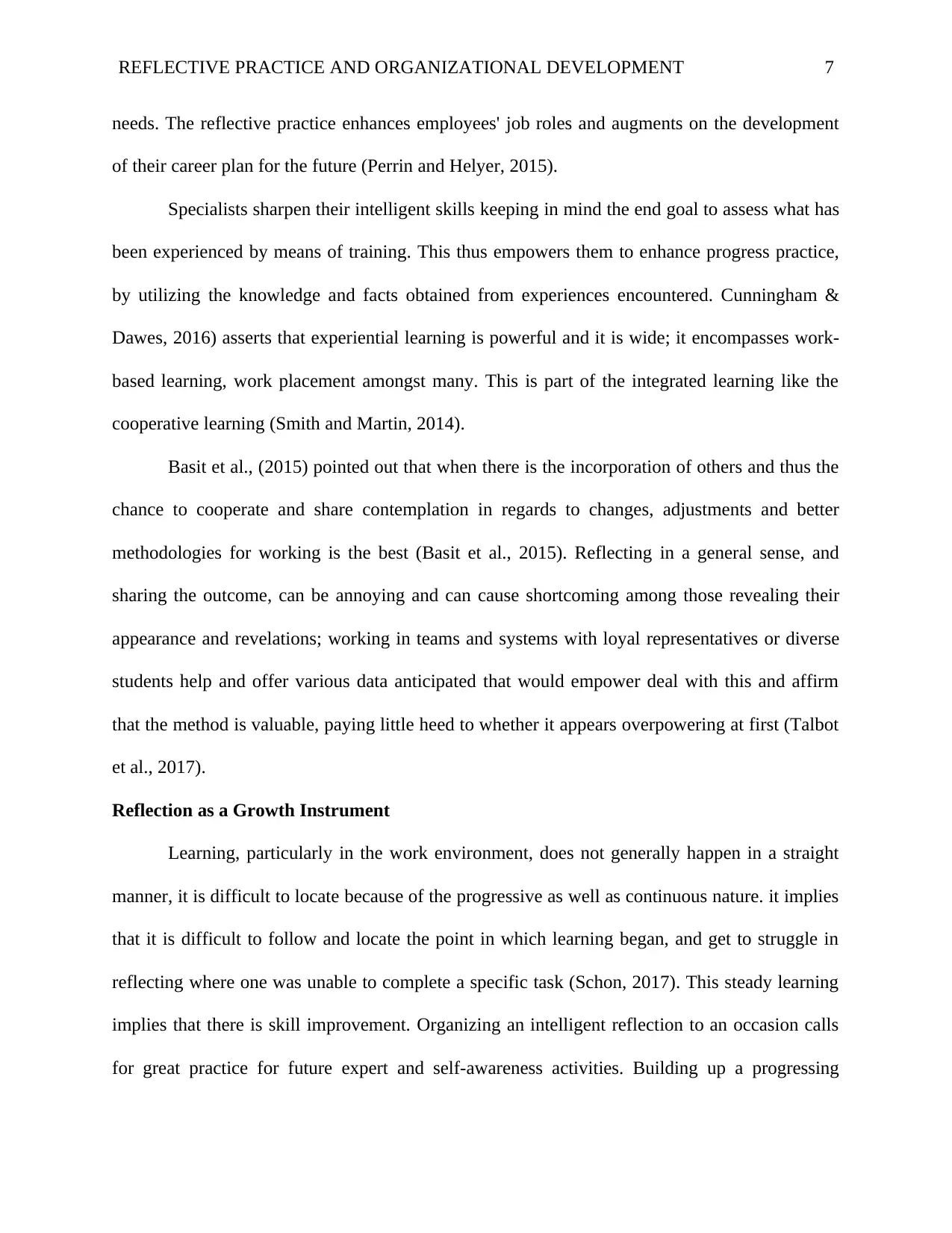
REFLECTIVE PRACTICE AND ORGANIZATIONAL DEVELOPMENT 7
needs. The reflective practice enhances employees' job roles and augments on the development
of their career plan for the future (Perrin and Helyer, 2015).
Specialists sharpen their intelligent skills keeping in mind the end goal to assess what has
been experienced by means of training. This thus empowers them to enhance progress practice,
by utilizing the knowledge and facts obtained from experiences encountered. Cunningham &
Dawes, 2016) asserts that experiential learning is powerful and it is wide; it encompasses work-
based learning, work placement amongst many. This is part of the integrated learning like the
cooperative learning (Smith and Martin, 2014).
Basit et al., (2015) pointed out that when there is the incorporation of others and thus the
chance to cooperate and share contemplation in regards to changes, adjustments and better
methodologies for working is the best (Basit et al., 2015). Reflecting in a general sense, and
sharing the outcome, can be annoying and can cause shortcoming among those revealing their
appearance and revelations; working in teams and systems with loyal representatives or diverse
students help and offer various data anticipated that would empower deal with this and affirm
that the method is valuable, paying little heed to whether it appears overpowering at first (Talbot
et al., 2017).
Reflection as a Growth Instrument
Learning, particularly in the work environment, does not generally happen in a straight
manner, it is difficult to locate because of the progressive as well as continuous nature. it implies
that it is difficult to follow and locate the point in which learning began, and get to struggle in
reflecting where one was unable to complete a specific task (Schon, 2017). This steady learning
implies that there is skill improvement. Organizing an intelligent reflection to an occasion calls
for great practice for future expert and self-awareness activities. Building up a progressing
needs. The reflective practice enhances employees' job roles and augments on the development
of their career plan for the future (Perrin and Helyer, 2015).
Specialists sharpen their intelligent skills keeping in mind the end goal to assess what has
been experienced by means of training. This thus empowers them to enhance progress practice,
by utilizing the knowledge and facts obtained from experiences encountered. Cunningham &
Dawes, 2016) asserts that experiential learning is powerful and it is wide; it encompasses work-
based learning, work placement amongst many. This is part of the integrated learning like the
cooperative learning (Smith and Martin, 2014).
Basit et al., (2015) pointed out that when there is the incorporation of others and thus the
chance to cooperate and share contemplation in regards to changes, adjustments and better
methodologies for working is the best (Basit et al., 2015). Reflecting in a general sense, and
sharing the outcome, can be annoying and can cause shortcoming among those revealing their
appearance and revelations; working in teams and systems with loyal representatives or diverse
students help and offer various data anticipated that would empower deal with this and affirm
that the method is valuable, paying little heed to whether it appears overpowering at first (Talbot
et al., 2017).
Reflection as a Growth Instrument
Learning, particularly in the work environment, does not generally happen in a straight
manner, it is difficult to locate because of the progressive as well as continuous nature. it implies
that it is difficult to follow and locate the point in which learning began, and get to struggle in
reflecting where one was unable to complete a specific task (Schon, 2017). This steady learning
implies that there is skill improvement. Organizing an intelligent reflection to an occasion calls
for great practice for future expert and self-awareness activities. Building up a progressing
Paraphrase This Document
Need a fresh take? Get an instant paraphrase of this document with our AI Paraphraser
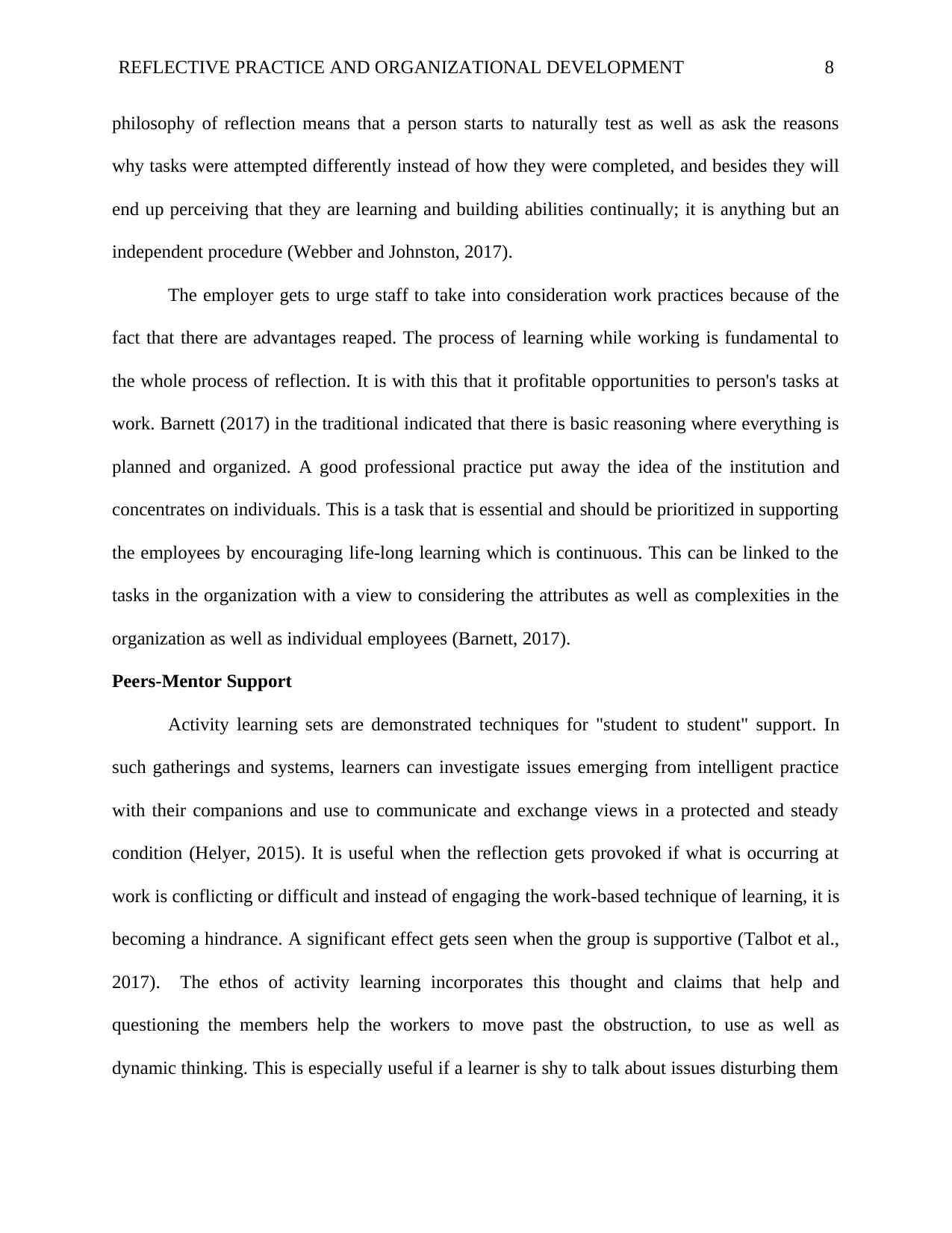
REFLECTIVE PRACTICE AND ORGANIZATIONAL DEVELOPMENT 8
philosophy of reflection means that a person starts to naturally test as well as ask the reasons
why tasks were attempted differently instead of how they were completed, and besides they will
end up perceiving that they are learning and building abilities continually; it is anything but an
independent procedure (Webber and Johnston, 2017).
The employer gets to urge staff to take into consideration work practices because of the
fact that there are advantages reaped. The process of learning while working is fundamental to
the whole process of reflection. It is with this that it profitable opportunities to person's tasks at
work. Barnett (2017) in the traditional indicated that there is basic reasoning where everything is
planned and organized. A good professional practice put away the idea of the institution and
concentrates on individuals. This is a task that is essential and should be prioritized in supporting
the employees by encouraging life-long learning which is continuous. This can be linked to the
tasks in the organization with a view to considering the attributes as well as complexities in the
organization as well as individual employees (Barnett, 2017).
Peers-Mentor Support
Activity learning sets are demonstrated techniques for "student to student" support. In
such gatherings and systems, learners can investigate issues emerging from intelligent practice
with their companions and use to communicate and exchange views in a protected and steady
condition (Helyer, 2015). It is useful when the reflection gets provoked if what is occurring at
work is conflicting or difficult and instead of engaging the work-based technique of learning, it is
becoming a hindrance. A significant effect gets seen when the group is supportive (Talbot et al.,
2017). The ethos of activity learning incorporates this thought and claims that help and
questioning the members help the workers to move past the obstruction, to use as well as
dynamic thinking. This is especially useful if a learner is shy to talk about issues disturbing them
philosophy of reflection means that a person starts to naturally test as well as ask the reasons
why tasks were attempted differently instead of how they were completed, and besides they will
end up perceiving that they are learning and building abilities continually; it is anything but an
independent procedure (Webber and Johnston, 2017).
The employer gets to urge staff to take into consideration work practices because of the
fact that there are advantages reaped. The process of learning while working is fundamental to
the whole process of reflection. It is with this that it profitable opportunities to person's tasks at
work. Barnett (2017) in the traditional indicated that there is basic reasoning where everything is
planned and organized. A good professional practice put away the idea of the institution and
concentrates on individuals. This is a task that is essential and should be prioritized in supporting
the employees by encouraging life-long learning which is continuous. This can be linked to the
tasks in the organization with a view to considering the attributes as well as complexities in the
organization as well as individual employees (Barnett, 2017).
Peers-Mentor Support
Activity learning sets are demonstrated techniques for "student to student" support. In
such gatherings and systems, learners can investigate issues emerging from intelligent practice
with their companions and use to communicate and exchange views in a protected and steady
condition (Helyer, 2015). It is useful when the reflection gets provoked if what is occurring at
work is conflicting or difficult and instead of engaging the work-based technique of learning, it is
becoming a hindrance. A significant effect gets seen when the group is supportive (Talbot et al.,
2017). The ethos of activity learning incorporates this thought and claims that help and
questioning the members help the workers to move past the obstruction, to use as well as
dynamic thinking. This is especially useful if a learner is shy to talk about issues disturbing them
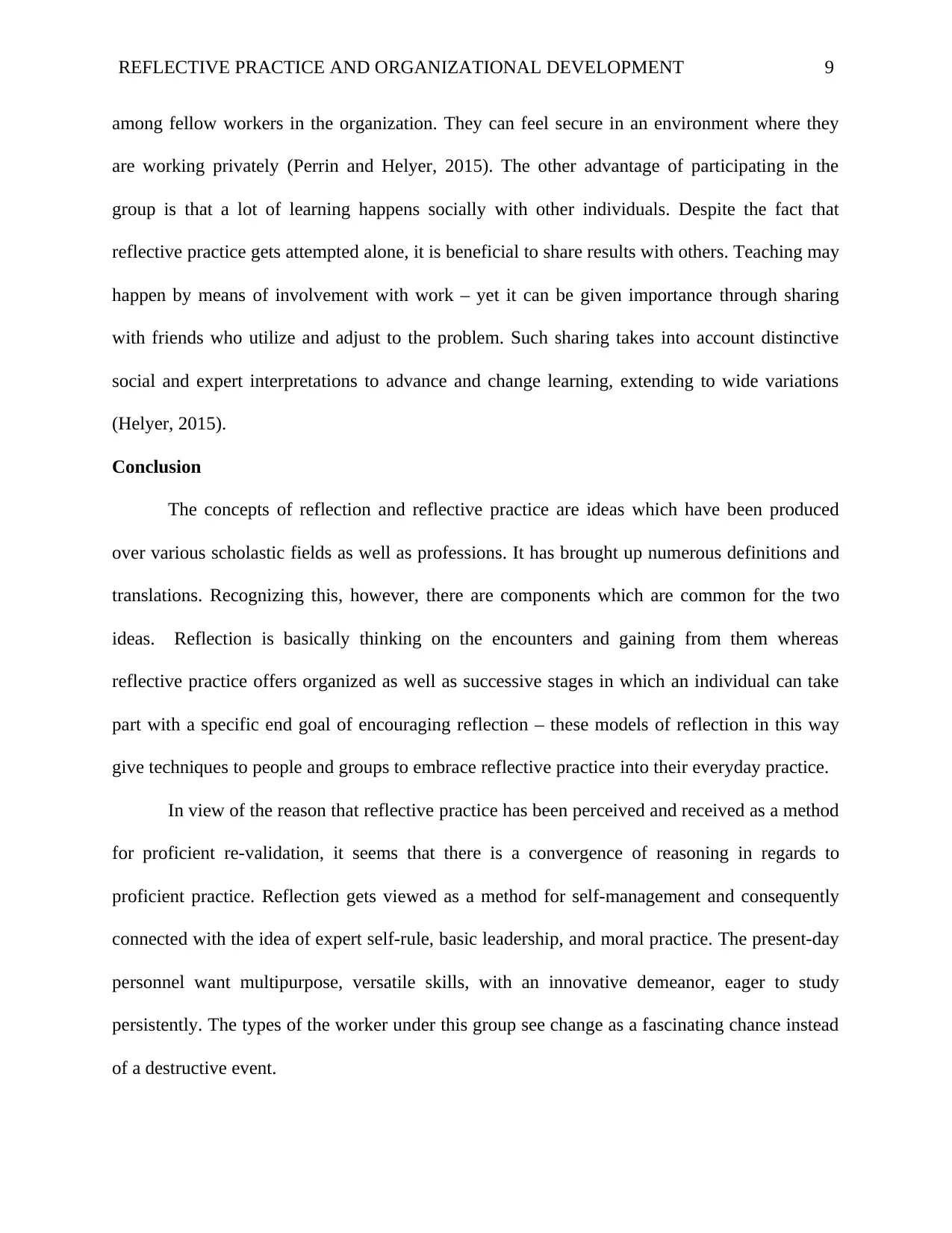
REFLECTIVE PRACTICE AND ORGANIZATIONAL DEVELOPMENT 9
among fellow workers in the organization. They can feel secure in an environment where they
are working privately (Perrin and Helyer, 2015). The other advantage of participating in the
group is that a lot of learning happens socially with other individuals. Despite the fact that
reflective practice gets attempted alone, it is beneficial to share results with others. Teaching may
happen by means of involvement with work – yet it can be given importance through sharing
with friends who utilize and adjust to the problem. Such sharing takes into account distinctive
social and expert interpretations to advance and change learning, extending to wide variations
(Helyer, 2015).
Conclusion
The concepts of reflection and reflective practice are ideas which have been produced
over various scholastic fields as well as professions. It has brought up numerous definitions and
translations. Recognizing this, however, there are components which are common for the two
ideas. Reflection is basically thinking on the encounters and gaining from them whereas
reflective practice offers organized as well as successive stages in which an individual can take
part with a specific end goal of encouraging reflection – these models of reflection in this way
give techniques to people and groups to embrace reflective practice into their everyday practice.
In view of the reason that reflective practice has been perceived and received as a method
for proficient re-validation, it seems that there is a convergence of reasoning in regards to
proficient practice. Reflection gets viewed as a method for self-management and consequently
connected with the idea of expert self-rule, basic leadership, and moral practice. The present-day
personnel want multipurpose, versatile skills, with an innovative demeanor, eager to study
persistently. The types of the worker under this group see change as a fascinating chance instead
of a destructive event.
among fellow workers in the organization. They can feel secure in an environment where they
are working privately (Perrin and Helyer, 2015). The other advantage of participating in the
group is that a lot of learning happens socially with other individuals. Despite the fact that
reflective practice gets attempted alone, it is beneficial to share results with others. Teaching may
happen by means of involvement with work – yet it can be given importance through sharing
with friends who utilize and adjust to the problem. Such sharing takes into account distinctive
social and expert interpretations to advance and change learning, extending to wide variations
(Helyer, 2015).
Conclusion
The concepts of reflection and reflective practice are ideas which have been produced
over various scholastic fields as well as professions. It has brought up numerous definitions and
translations. Recognizing this, however, there are components which are common for the two
ideas. Reflection is basically thinking on the encounters and gaining from them whereas
reflective practice offers organized as well as successive stages in which an individual can take
part with a specific end goal of encouraging reflection – these models of reflection in this way
give techniques to people and groups to embrace reflective practice into their everyday practice.
In view of the reason that reflective practice has been perceived and received as a method
for proficient re-validation, it seems that there is a convergence of reasoning in regards to
proficient practice. Reflection gets viewed as a method for self-management and consequently
connected with the idea of expert self-rule, basic leadership, and moral practice. The present-day
personnel want multipurpose, versatile skills, with an innovative demeanor, eager to study
persistently. The types of the worker under this group see change as a fascinating chance instead
of a destructive event.
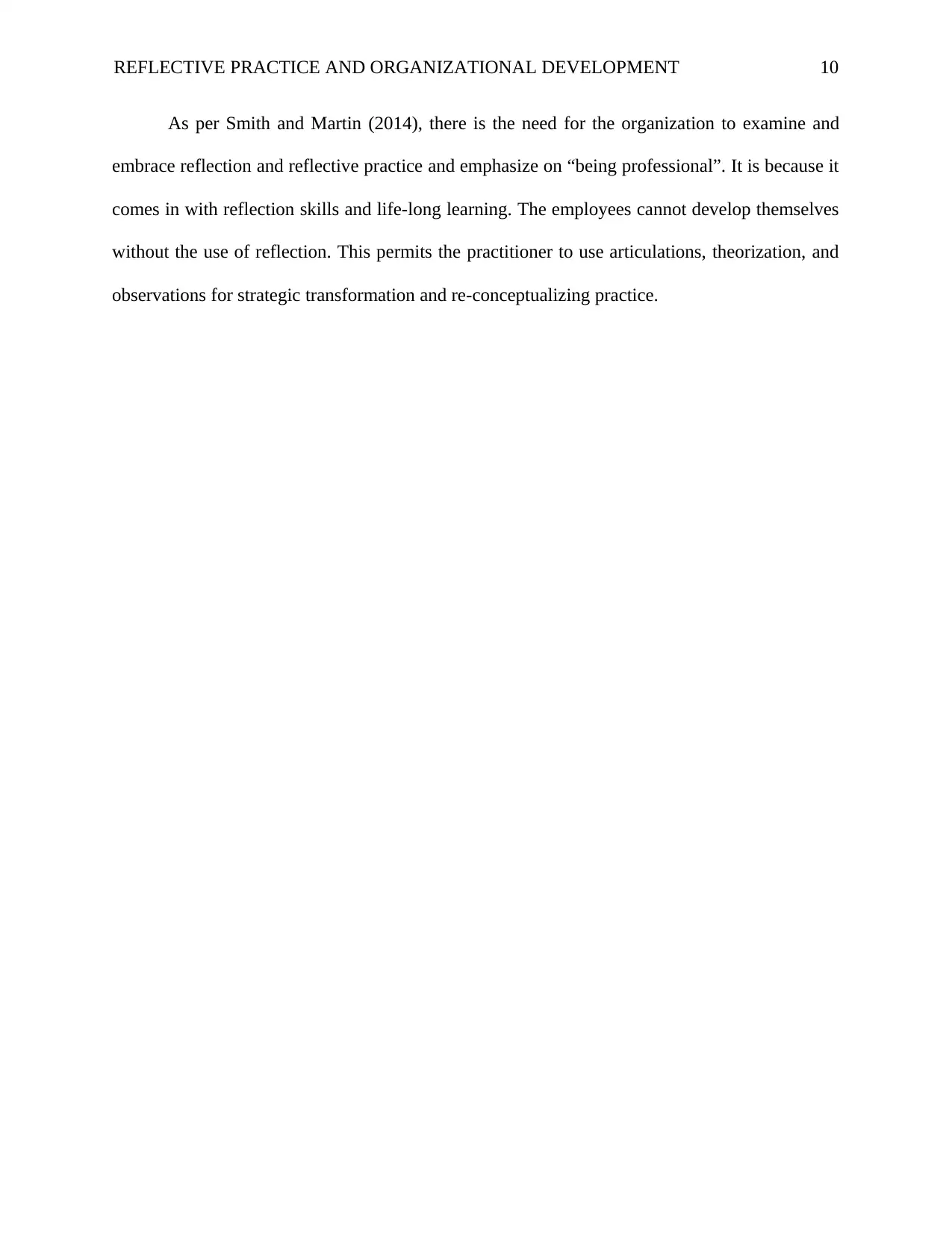
REFLECTIVE PRACTICE AND ORGANIZATIONAL DEVELOPMENT 10
As per Smith and Martin (2014), there is the need for the organization to examine and
embrace reflection and reflective practice and emphasize on “being professional”. It is because it
comes in with reflection skills and life-long learning. The employees cannot develop themselves
without the use of reflection. This permits the practitioner to use articulations, theorization, and
observations for strategic transformation and re-conceptualizing practice.
As per Smith and Martin (2014), there is the need for the organization to examine and
embrace reflection and reflective practice and emphasize on “being professional”. It is because it
comes in with reflection skills and life-long learning. The employees cannot develop themselves
without the use of reflection. This permits the practitioner to use articulations, theorization, and
observations for strategic transformation and re-conceptualizing practice.
Secure Best Marks with AI Grader
Need help grading? Try our AI Grader for instant feedback on your assignments.
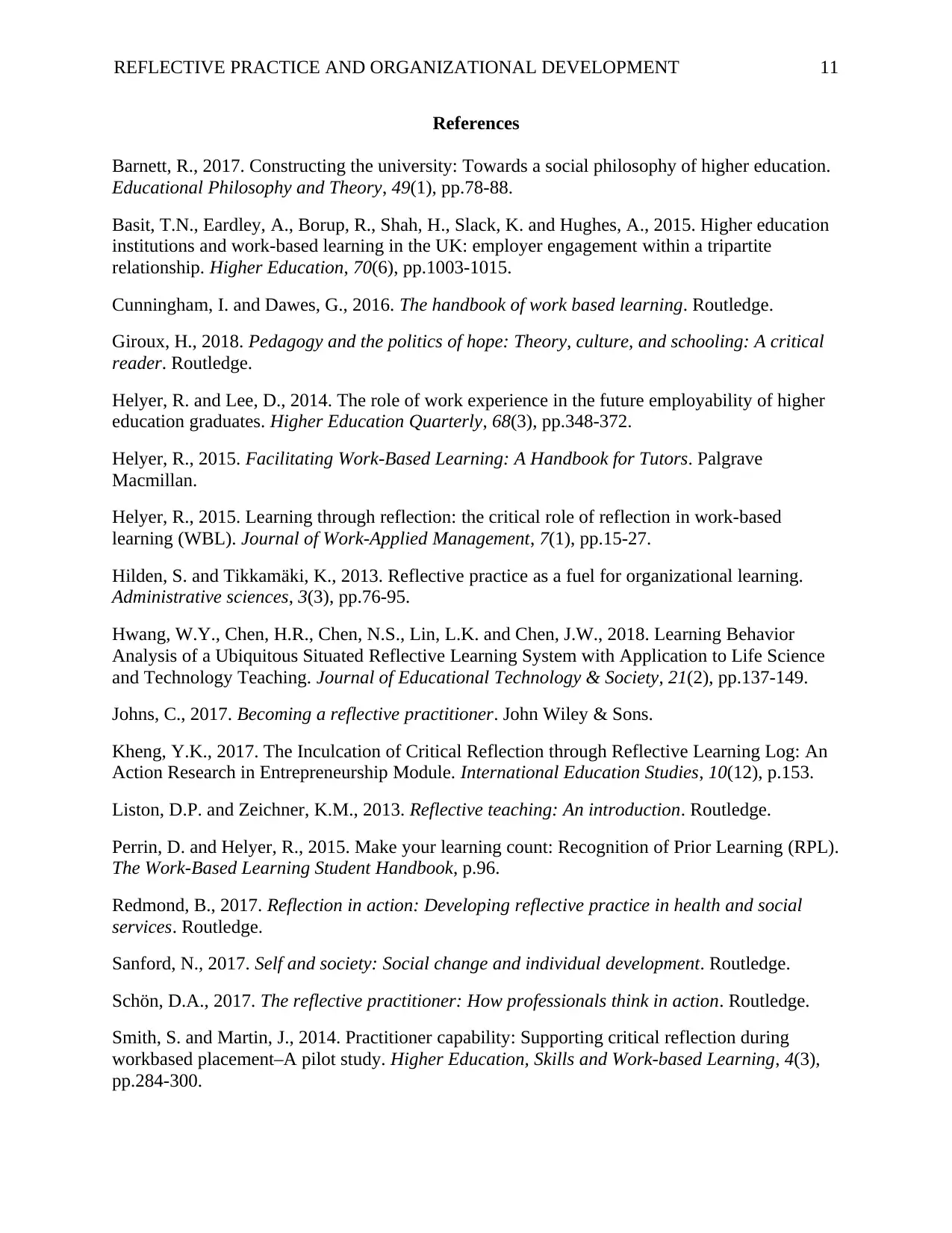
REFLECTIVE PRACTICE AND ORGANIZATIONAL DEVELOPMENT 11
References
Barnett, R., 2017. Constructing the university: Towards a social philosophy of higher education.
Educational Philosophy and Theory, 49(1), pp.78-88.
Basit, T.N., Eardley, A., Borup, R., Shah, H., Slack, K. and Hughes, A., 2015. Higher education
institutions and work-based learning in the UK: employer engagement within a tripartite
relationship. Higher Education, 70(6), pp.1003-1015.
Cunningham, I. and Dawes, G., 2016. The handbook of work based learning. Routledge.
Giroux, H., 2018. Pedagogy and the politics of hope: Theory, culture, and schooling: A critical
reader. Routledge.
Helyer, R. and Lee, D., 2014. The role of work experience in the future employability of higher
education graduates. Higher Education Quarterly, 68(3), pp.348-372.
Helyer, R., 2015. Facilitating Work-Based Learning: A Handbook for Tutors. Palgrave
Macmillan.
Helyer, R., 2015. Learning through reflection: the critical role of reflection in work-based
learning (WBL). Journal of Work-Applied Management, 7(1), pp.15-27.
Hilden, S. and Tikkamäki, K., 2013. Reflective practice as a fuel for organizational learning.
Administrative sciences, 3(3), pp.76-95.
Hwang, W.Y., Chen, H.R., Chen, N.S., Lin, L.K. and Chen, J.W., 2018. Learning Behavior
Analysis of a Ubiquitous Situated Reflective Learning System with Application to Life Science
and Technology Teaching. Journal of Educational Technology & Society, 21(2), pp.137-149.
Johns, C., 2017. Becoming a reflective practitioner. John Wiley & Sons.
Kheng, Y.K., 2017. The Inculcation of Critical Reflection through Reflective Learning Log: An
Action Research in Entrepreneurship Module. International Education Studies, 10(12), p.153.
Liston, D.P. and Zeichner, K.M., 2013. Reflective teaching: An introduction. Routledge.
Perrin, D. and Helyer, R., 2015. Make your learning count: Recognition of Prior Learning (RPL).
The Work-Based Learning Student Handbook, p.96.
Redmond, B., 2017. Reflection in action: Developing reflective practice in health and social
services. Routledge.
Sanford, N., 2017. Self and society: Social change and individual development. Routledge.
Schön, D.A., 2017. The reflective practitioner: How professionals think in action. Routledge.
Smith, S. and Martin, J., 2014. Practitioner capability: Supporting critical reflection during
workbased placement–A pilot study. Higher Education, Skills and Work-based Learning, 4(3),
pp.284-300.
References
Barnett, R., 2017. Constructing the university: Towards a social philosophy of higher education.
Educational Philosophy and Theory, 49(1), pp.78-88.
Basit, T.N., Eardley, A., Borup, R., Shah, H., Slack, K. and Hughes, A., 2015. Higher education
institutions and work-based learning in the UK: employer engagement within a tripartite
relationship. Higher Education, 70(6), pp.1003-1015.
Cunningham, I. and Dawes, G., 2016. The handbook of work based learning. Routledge.
Giroux, H., 2018. Pedagogy and the politics of hope: Theory, culture, and schooling: A critical
reader. Routledge.
Helyer, R. and Lee, D., 2014. The role of work experience in the future employability of higher
education graduates. Higher Education Quarterly, 68(3), pp.348-372.
Helyer, R., 2015. Facilitating Work-Based Learning: A Handbook for Tutors. Palgrave
Macmillan.
Helyer, R., 2015. Learning through reflection: the critical role of reflection in work-based
learning (WBL). Journal of Work-Applied Management, 7(1), pp.15-27.
Hilden, S. and Tikkamäki, K., 2013. Reflective practice as a fuel for organizational learning.
Administrative sciences, 3(3), pp.76-95.
Hwang, W.Y., Chen, H.R., Chen, N.S., Lin, L.K. and Chen, J.W., 2018. Learning Behavior
Analysis of a Ubiquitous Situated Reflective Learning System with Application to Life Science
and Technology Teaching. Journal of Educational Technology & Society, 21(2), pp.137-149.
Johns, C., 2017. Becoming a reflective practitioner. John Wiley & Sons.
Kheng, Y.K., 2017. The Inculcation of Critical Reflection through Reflective Learning Log: An
Action Research in Entrepreneurship Module. International Education Studies, 10(12), p.153.
Liston, D.P. and Zeichner, K.M., 2013. Reflective teaching: An introduction. Routledge.
Perrin, D. and Helyer, R., 2015. Make your learning count: Recognition of Prior Learning (RPL).
The Work-Based Learning Student Handbook, p.96.
Redmond, B., 2017. Reflection in action: Developing reflective practice in health and social
services. Routledge.
Sanford, N., 2017. Self and society: Social change and individual development. Routledge.
Schön, D.A., 2017. The reflective practitioner: How professionals think in action. Routledge.
Smith, S. and Martin, J., 2014. Practitioner capability: Supporting critical reflection during
workbased placement–A pilot study. Higher Education, Skills and Work-based Learning, 4(3),
pp.284-300.
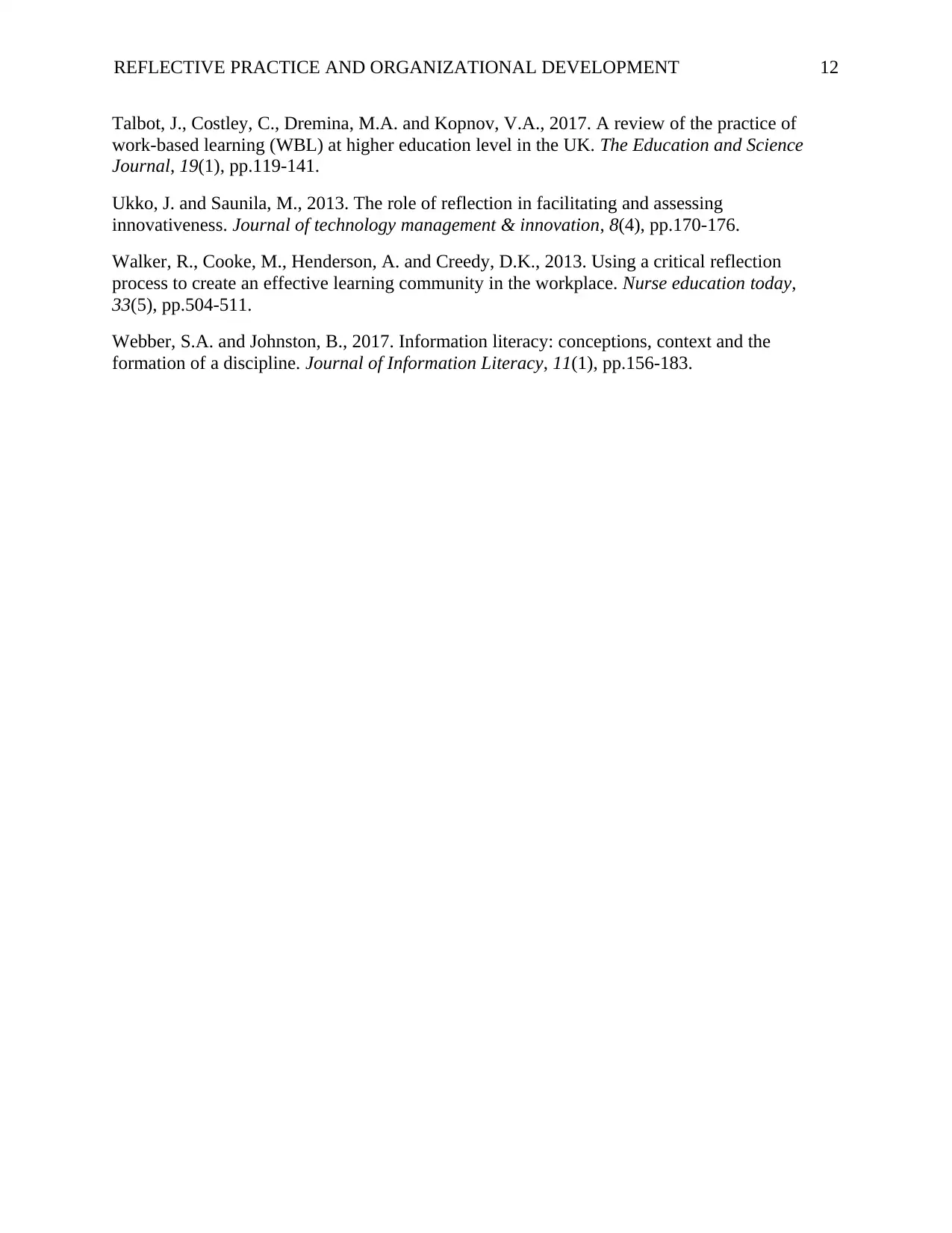
REFLECTIVE PRACTICE AND ORGANIZATIONAL DEVELOPMENT 12
Talbot, J., Costley, C., Dremina, M.A. and Kopnov, V.A., 2017. A review of the practice of
work-based learning (WBL) at higher education level in the UK. The Education and Science
Journal, 19(1), pp.119-141.
Ukko, J. and Saunila, M., 2013. The role of reflection in facilitating and assessing
innovativeness. Journal of technology management & innovation, 8(4), pp.170-176.
Walker, R., Cooke, M., Henderson, A. and Creedy, D.K., 2013. Using a critical reflection
process to create an effective learning community in the workplace. Nurse education today,
33(5), pp.504-511.
Webber, S.A. and Johnston, B., 2017. Information literacy: conceptions, context and the
formation of a discipline. Journal of Information Literacy, 11(1), pp.156-183.
Talbot, J., Costley, C., Dremina, M.A. and Kopnov, V.A., 2017. A review of the practice of
work-based learning (WBL) at higher education level in the UK. The Education and Science
Journal, 19(1), pp.119-141.
Ukko, J. and Saunila, M., 2013. The role of reflection in facilitating and assessing
innovativeness. Journal of technology management & innovation, 8(4), pp.170-176.
Walker, R., Cooke, M., Henderson, A. and Creedy, D.K., 2013. Using a critical reflection
process to create an effective learning community in the workplace. Nurse education today,
33(5), pp.504-511.
Webber, S.A. and Johnston, B., 2017. Information literacy: conceptions, context and the
formation of a discipline. Journal of Information Literacy, 11(1), pp.156-183.
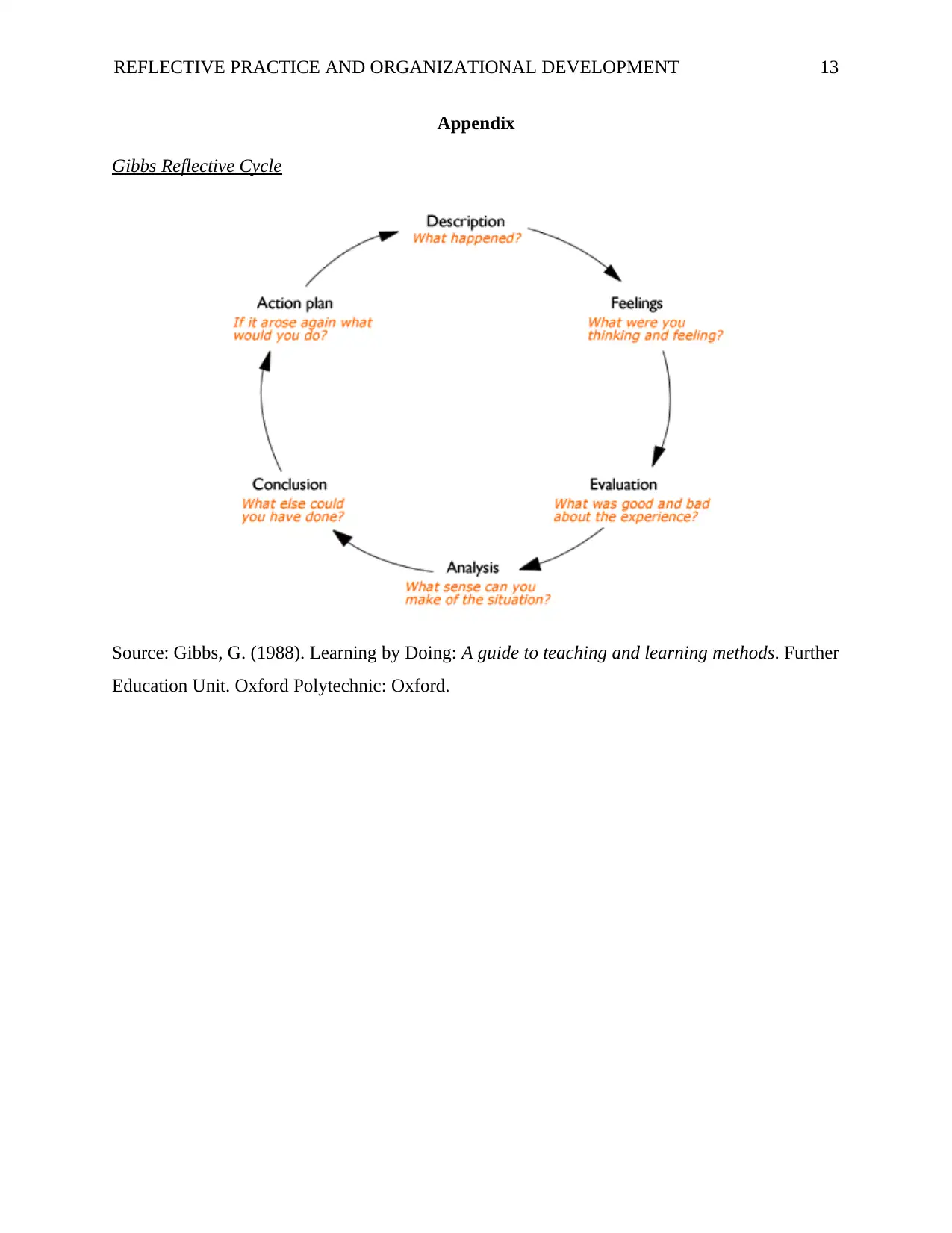
REFLECTIVE PRACTICE AND ORGANIZATIONAL DEVELOPMENT 13
Appendix
Gibbs Reflective Cycle
Source: Gibbs, G. (1988). Learning by Doing: A guide to teaching and learning methods. Further
Education Unit. Oxford Polytechnic: Oxford.
Appendix
Gibbs Reflective Cycle
Source: Gibbs, G. (1988). Learning by Doing: A guide to teaching and learning methods. Further
Education Unit. Oxford Polytechnic: Oxford.
1 out of 13
Related Documents
Your All-in-One AI-Powered Toolkit for Academic Success.
+13062052269
info@desklib.com
Available 24*7 on WhatsApp / Email
![[object Object]](/_next/static/media/star-bottom.7253800d.svg)
Unlock your academic potential
© 2024 | Zucol Services PVT LTD | All rights reserved.



